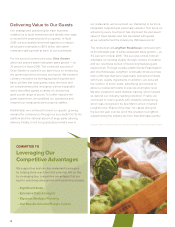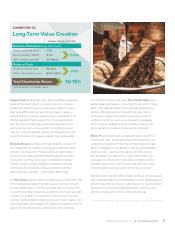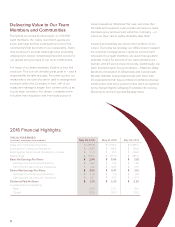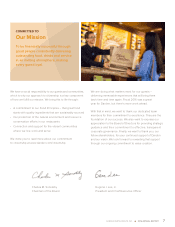Red Lobster 2016 Annual Report Download - page 18
Download and view the complete annual report
Please find page 18 of the 2016 Red Lobster annual report below. You can navigate through the pages in the report by either clicking on the pages listed below, or by using the keyword search tool below to find specific information within the annual report.
MANAGEMENT’S DISCUSSION AND ANALYSIS
OF FINANCIAL CONDITION AND RESULTS OF OPERATIONS
DARDEN
14
Total operating costs and expenses from continuing operations were
$6.31 billion in fiscal 2016, $6.40 billion in fiscal 2015 and $5.98 billion in
fiscal 2014. As a percent of sales, total costs and expenses from continuing
operations were 91.0 percent in fiscal 2016, 94.6 percent in fiscal 2015
and 95.1 percent in fiscal 2014.
Fiscal 2016 Compared to Fiscal 2015:
• Food and beverage costs decreased as a percent of sales as a result
of favorable menu mix and pricing, cost savings initiatives and food
cost deflation, primarily seafood and dairy.
• Restaurant labor costs were flat as a percent of sales as wage-rate
inflation, higher manager bonus and salary costs were offset by
sales leverage.
• Restaurant expenses (which include utilities, repairs and
maintenance, credit card, lease, property tax, workers’ compen-
sation, new restaurant pre-opening and other restaurant-level
operating expenses) increased as a percent of sales, primarily as a
result of increased rent expense partially offset by sales leverage
and cost savings initiatives.
• Marketing expenses decreased as a percent of sales, primarily as a
result of sales leverage.
• General and administrative expenses decreased as a percent of
sales, primarily due to lower general and administrative expenses
incurred in fiscal 2016 related to the real estate plan implementation
as compared to the strategic action plan costs incurred in fiscal
2015. General and administrative expenses as a percent of sales also
decreased as a result of sales leverage, support cost savings and the
favorable settlement of legal matters.
• Depreciation and amortization expense decreased as a percent
of sales primarily from the impact of the spin-off of Four Corners,
completed sale-leaseback transactions and sales leverage.
• Impairments and disposal of assets, net, decreased as a percent
of sales primarily due to higher restaurant-related impairments in
fiscal 2015.
Fiscal 2015 Compared to Fiscal 2014:
• Food and beverage costs increased as percent of sales as a result
of food cost inflation, primarily dairy and beef, and increased costs for
promotional items, partially offset by pricing and favorable menu mix.
• Restaurant labor costs decreased as a percent of sales primarily as a
result of sales leverage.
• Restaurant expenses (which include utilities, repairs and maintenance,
credit card, lease, property tax, workers’ compensation, new restau-
rant pre-opening, rent expense and other restaurant-level operating
expenses) decreased as a percent of sales, primarily as a result of
sales leverage and lower new restaurant pre-opening expenses.
• Marketing expenses decreased as a percent of sales, primarily as a
result of sales leverage and reduced media costs.
• General and administrative expenses decreased as a percent of
sales, primarily as a result of sales leverage and support cost savings
net of costs related to implementation of the strategic action plan.
• Depreciation and amortization expense as a percent of sales
decreased primarily due to lower net new restaurants and remodel
activities as compared to the prior year.
INTEREST EXPENSE
Net interest expense decreased as a percent of sales in fiscal 2016 primarily
due to lower average debt balances in fiscal 2016 as compared to fiscal
2015 related to the retirement of $1.03 billion in principal of long-term debt
in fiscal 2016. The decrease was partially offset by higher debt retirement
costs of $106.8 million in fiscal 2016 compared to debt retirement costs of
$91.3 million in fiscal 2015. Net interest expense increased as a percent of
sales in fiscal 2015 as compared to fiscal 2014 primarily due to $91.3 million
of debt retirement costs related to the retirement of $1.01 billion in principal
of long-term debt in fiscal 2015.
INCOME TAXES
The effective income tax rates for fiscal 2016, 2015 and 2014 for continuing
operations were 20.0 percent, (12.0) percent and (4.9) percent, respectively.
Our effective tax rate from continuing operations was negative in both fiscal
2015 and fiscal 2014 primarily due to the impact of certain tax credits on
lower earnings before income taxes driven primarily by costs incurred related
to our strategic action plan. The increase in our effective tax rate for fiscal
2016 compared to fiscal 2015 is primarily due to higher earnings before
income taxes. The decrease in our effective rate for fiscal 2015 compared to
fiscal 2014 is primarily attributable to the impact of the favorable resolution
of prior-year tax matters.
NET EARNINGS AND NET EARNINGS PER SHARE
FROM CONTINUING OPERATIONS
Net earnings from continuing operations for fiscal 2016 were $359.7 million
($2.78 per diluted share) compared with net earnings from continuing
operations for fiscal 2015 of $196.4 million ($1.51 per diluted share) and
net earnings from continuing operations for fiscal 2014 of $183.2 million
($1.38 per diluted share).
Net earnings from continuing operations for fiscal 2016 increased
83.1 percent and diluted net earnings per share from continuing operations
increased 84.1 percent compared with fiscal 2015, primarily due to
increased sales, lower food and beverage costs, marketing expenses, gen-
eral and administrative expenses, depreciation and amortization expenses
and impairments and disposal of assets, net as a percent of sales, partially
offset by higher restaurant expenses as a percent of sales and a higher
effective income tax rate. Our diluted net earnings per share from continuing
operations for fiscal 2016 were adversely impacted by approximately
$0.51 due to debt retirement costs and approximately $0.26 related to the
real estate plan implementation and positively impacted by approximately
$0.02 due to a tax benefit associated with the prior year lobster
aquaculture divestiture.
Net earnings from continuing operations for fiscal 2015 increased
7.2 percent and diluted net earnings per share from continuing operations
increased 9.4 percent compared with fiscal 2014, primarily due to increased
sales and a lower effective income tax rate and lower restaurant labor
expenses, restaurant expenses and marketing expenses as a percent of
sales, partially offset by higher food and beverage costs, general and
administrative expenses and impairments and disposal of assets, net as
a percent of sales. Our diluted net earnings per share from continuing
operations for fiscal 2015 were adversely impacted by approximately
$0.42 related to debt retirement costs and approximately $0.68 due to
the combined impact of a tax benefit related to exiting from our lobster
aquaculture project and legal, financial advisory and other costs related to
implementation of the strategic action plan and asset impairments.
























